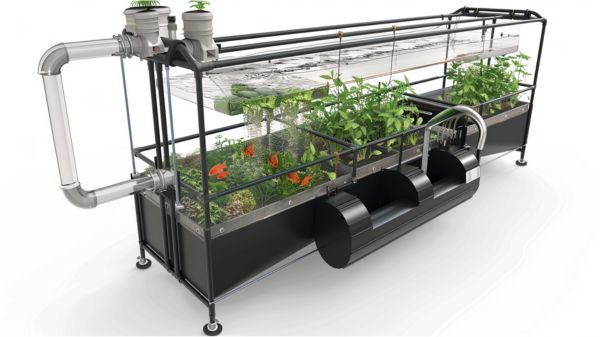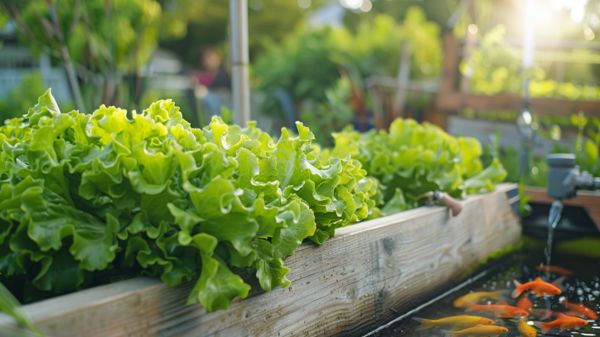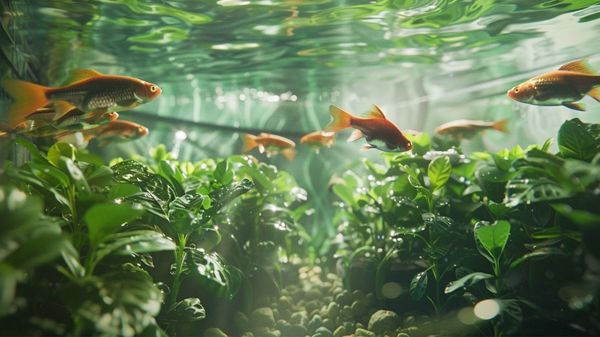Did you know that aquaponics can produce up to ten times more vegetables compared to traditional gardening in the same amount of space? With that in mind, mastering the art of DIY aquaponic system design is essential.
From selecting the right fish and plants to ensuring efficient water circulation and monitoring crucial parameters, there are seven key tips that can make or break your system’s success. Stick around to uncover these fundamental strategies that will set you on the path to a thriving aquaponic setup.

Key Takeaways
- Prioritize sunlight exposure and space constraints for optimal plant growth.
- Assess available space and resources for efficient system scale.
- Regularly monitor water quality and temperature for thriving fish and plants.
- Troubleshoot issues promptly and seek advice for system optimization.
Location Considerations
When selecting the location for your DIY aquaponic system design, prioritize sunlight exposure and temperature stability for optimal plant growth. Adequate sunlight is crucial for photosynthesis, while stable temperatures help maintain plant health.
Ensure easy access to a water source to simplify system maintenance. Evaluate space constraints carefully to accommodate the fish tank, grow bed, and components effectively.
Watch out for potential pests and environmental factors that could disrupt the system’s stability. Choose a location with good ventilation and airflow to prevent humidity buildup, which can affect plant health negatively.
System Size and Scale Planning
When planning the size and scale of your aquaponic system, ensure to consider the available space and desired production capacity. Factor in the number of fish and plants you aim to cultivate for an efficient system. Plan for future expansion by leaving room for additional grow beds or fish tanks in your design.
Size Considerations
To determine the appropriate size for your aquaponic system, assess the available space and consider your goals and needs. Plan the system scale by evaluating the number of fish and plants you aim to cultivate for efficient resource utilization. Factor in space requirements for the fish tank, grow bed, plumbing, and essential equipment to optimize functionality.
Tailor the system size to your available space while maximizing fish and plant growth potential without overcrowding. Proper sizing ensures a balanced ecosystem, promoting optimal conditions for plant growth and fish health. Balancing the components in your aquaponic system is crucial for creating a harmonious environment that supports both plant cultivation and fish well-being.
Scale Efficiency
For optimal resource utilization and productivity in your DIY aquaponics setup, carefully assess your available space, goals, and resources when determining the scale of your system. To achieve system scale efficiency, follow these tips:
- Determine the scale based on available space, goals, and resources.
- Consider fish stocking density and plant growth in system size planning.
- Ensure a balance between fish stocking density and plant growth for optimal results.
- Proper planning of system size and scale helps maximize efficiency.
- Matching the system size to your needs minimizes waste and enhances overall productivity.
Fish and Plant Selection Tips
When choosing fish species for your aquaponic system, opt for hardy varieties like Tilapia or Catfish that grow quickly.
Consider plant options such as Lettuce, Herbs, and Tomatoes that thrive in this environment with the right nutrients.
Ensure compatibility between fish and plants by matching temperature needs, feeding habits, and space utilization in your system.
Fish Compatibility Tips
Consider the water conditions and temperature requirements of both your fish and plants when selecting species for your aquaponic system to ensure compatibility and a thriving environment.
- Choose fish species that thrive in the same water conditions as your selected plants.
- Consider the temperature requirements of both the fish and plants.
- Avoid mixing aggressive or predatory fish with delicate or slow-growing plants.
- Select fish species that produce waste suitable for plant nutrient needs.
- Research the growth rates of both fish and plants for compatible feeding schedules and space utilization.
Plant Nutrient Requirements
Select fish species that can provide the specific nutrients required by your chosen plants for optimal growth in your aquaponic system. Different plants have varying nutrient needs, so it’s essential to match them with fish species that can meet those requirements.
Consider the growth rates of fish to ensure a continuous nutrient supply for your plants. For example, leafy greens may need more nitrogen, while fruiting plants might require additional potassium.
By understanding these nutrient requirements and choosing fish species accordingly, you can create a balanced system where both fish and plants thrive.
Check the table below for some examples of fish species and the nutrients they can provide for optimal plant growth in your DIY aquaponic system.
| Fish Species | Nutrient Supply |
|---|---|
| Tilapia | Nitrogen, Phosphorus |
| Goldfish | Potassium, Magnesium |
| Catfish | Calcium, Iron |
Balanced Ecosystem Considerations
To achieve a harmonious and thriving aquaponic system, ensure a balanced ecosystem by carefully selecting fish and plant species that complement each other’s environmental requirements. When designing your DIY aquaponic system, consider the following tips for fish and plant selection:
- Select fish species based on water temperature compatibility, growth rates, and market demand.
- Choose plant varieties considering plant spacing, light requirements, and nutrient needs.
- Maintain a balanced fish to plant ratio for optimal nutrient cycling and system health.
- Monitor water parameters like pH levels, ammonia, nitrites, and nitrates for a healthy ecosystem.
- Opt for fish and plant species compatible in environmental requirements to create a harmonious aquaponic system.
Tools and Materials Checklist
For efficient assembly and functionality of your DIY aquaponic system, gather essential tools like a drill, saw, level, measuring tape, and screwdriver, along with materials such as PVC pipes, fittings, grow bed containers, a water pump, an air pump, and tubing. These tools are crucial for precise cutting, drilling, and assembly, ensuring the success of your project.
Using quality materials like PVC pipes and fittings guarantees durability and water-tight connections, essential for optimal performance of your aquaponics system. The water pump and air pump are vital components for maintaining a healthy environment for your plants and fish.
Efficient System Design Strategies
To ensure the efficiency and productivity of your DIY aquaponic system, strategic design considerations must be made, encompassing proper sizing of fish tanks and grow beds, optimal water circulation systems, effective filtration methods, energy-efficient lighting solutions, and space-saving vertical designs.
- Properly size fish tanks and grow beds
- Design efficient water circulation systems for optimal nutrient distribution
- Utilize appropriate filtration methods for maintaining water quality
- Implement energy-efficient lighting solutions for plant growth
- Consider space-saving vertical designs for maximizing production
These strategies are essential for creating a well-functioning aquaponic system that promotes healthy plant growth, supports fish health, and maximizes the efficient use of space and resources.
Proper Grow Bed Construction Techniques
Constructing a grow bed for your aquaponic system involves selecting a suitable container and filling it with an appropriate media to support plant growth. Choose a container like a plastic or wooden frame lined with a pond liner.
Fill the grow bed with media such as expanded clay pebbles, gravel, or volcanic rock. Ensure proper drainage with pipes or outlets to prevent waterlogging. Consider the depth to accommodate plant roots adequately.
Implement a bell siphon or flood and drain system for efficient water distribution and oxygenation in the grow bed. These techniques are crucial for the success of your aquaponics system, providing a healthy environment for both plants and fish.
Essential Water Monitoring Practices
After establishing a well-constructed grow bed, the next crucial step in maintaining a successful aquaponic system is to implement essential water monitoring practices.
- Monitor pH levels regularly to ensure optimal conditions for both fish and plants.
- Test ammonia levels to prevent toxicity and maintain a healthy environment.
- Check nitrite levels to ensure the nitrogen cycle is functioning properly.
- Monitor nitrate levels to prevent nutrient imbalances in the system.
- Regularly monitor water temperature to ensure it falls within the ideal range for the species in your aquaponics system.
Frequently Asked Questions
What Is the Key to a Successful Aquaponics System?
To succeed in aquaponics, maintain excellent water quality, nutrient balance, and fish health. Ensure plant growth by managing pH, temperature, and oxygen levels. Regularly maintain your system for efficiency, and manage pests effectively.
What Is Needed to Create a Aquaponics System?
To create an aquaponics system, you’ll need components like a fish tank, grow bed, pumps, and tubing. Ensure water quality for fish health and plant growth. Maintain nutrient balance, monitor pH, temperature, and oxygen levels for biofilter function and pest prevention.
What Are the 4 Things That Need to Be Tested Regularly in an Aquaponics System?
To maintain water quality in your aquaponics system, regularly test pH, nutrient levels, oxygen, and temperature. Monitoring ensures ideal conditions for fish health, plant growth, and system efficiency. Don’t forget about pest control and proper maintenance for optimal results.
What Is the Basic Principles of an Aquaponics System?
To understand aquaponics, grasp the symbiosis between fish and plants. Fish waste fertilizes plants while plants purify water for fish. Key aspects include water filtration, nutrient balance, fish health, plant growth, system maintenance, pest control, temperature, oxygen, pH, and harvesting produce.

Conclusion
Remember that ‘slow and steady wins the race’ when it comes to DIY aquaponic system design. By carefully planning, selecting the right components, and monitoring water parameters, you can ensure the success of your system.
With dedication and attention to detail, your aquaponic garden will thrive and provide you with a sustainable source of fresh fish and vegetables. Keep learning, adapting, and enjoying the rewards of your hard work.




